- Details
-
Written by Tracy Powell
Cloudstone revealed at last!
By Tracy Powell
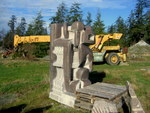 Remember Hank Nelson? He used to be the supplier of power on the field of Camp Brotherhood. For many years, Hank fed the compressor, kicked the balky generators, scrounged up the last hose and fitting and extension cord, and kept our symposium roaring like the well-oiled machine we all have come to expect. And once in a great while he would disappear into his own carving station, with water and noise flying, and turn the hardest stones into provocative little knots and puzzles. And how Hank could put away the meals!
Remember Hank Nelson? He used to be the supplier of power on the field of Camp Brotherhood. For many years, Hank fed the compressor, kicked the balky generators, scrounged up the last hose and fitting and extension cord, and kept our symposium roaring like the well-oiled machine we all have come to expect. And once in a great while he would disappear into his own carving station, with water and noise flying, and turn the hardest stones into provocative little knots and puzzles. And how Hank could put away the meals!
In case you haven’t noticed, Hank has been absent for a few years, only popping in on rare occasions just to make sure we were all still here. And what has he been up to?
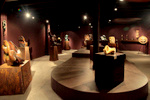 Cloudstone Sculpture Park. You gotta go see it. It’s over on South Whidbey, on a hill above Mutiny Bay. On September 26, in conjunction with the Whidbey Island Artists Studio Tour and Enso House, Hank opened his new gallery, and invited a couple hundred of his closest friends to tour the Park. The display of bronzes in the gallery is sensational, the cast iron pieces fantastic, the food was wonderful, served on 5 ton granite tables, and the band was a delight, but a little difficult to focus on. Walking around the Park with several groups of visitors, including Hank’s son and daughter and their families, all I could hear were oohs and aahs. Everyone was astounded at the size of the red granite sculptures, half a dozen of them - ten tons and more each.
Cloudstone Sculpture Park. You gotta go see it. It’s over on South Whidbey, on a hill above Mutiny Bay. On September 26, in conjunction with the Whidbey Island Artists Studio Tour and Enso House, Hank opened his new gallery, and invited a couple hundred of his closest friends to tour the Park. The display of bronzes in the gallery is sensational, the cast iron pieces fantastic, the food was wonderful, served on 5 ton granite tables, and the band was a delight, but a little difficult to focus on. Walking around the Park with several groups of visitors, including Hank’s son and daughter and their families, all I could hear were oohs and aahs. Everyone was astounded at the size of the red granite sculptures, half a dozen of them - ten tons and more each.
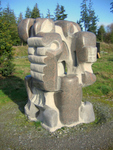 As Kirk Mc Lean observed, Hank has found his proper scale. And not size alone, the complexity, the engineering, the vision. Giant steel constructions reach for the sky. Some of the earthworks are huge cones of cobbles, with spiraling settings of larger stones, and capped with gray granite sculptures, standing and reclining. These are one and two ton pieces, but are dwarfed by their settings. There are canyons carved in the ground, scaped with steel and concrete rubble, like apocalyptic visions you can walk through, if you dare. We were all dumbfounded and overwhelmed. Our old buddy Hank Nelson is creating a marvel to rival any sculpture park anywhere. Uniquely inspiring, Hank’s work is beyond what most of us ever hope for, in power, intensity, and presence. It must be seen and touched, and walked in to be believed. By all means, get out to Whidbey and have a look. You will be amazed!
As Kirk Mc Lean observed, Hank has found his proper scale. And not size alone, the complexity, the engineering, the vision. Giant steel constructions reach for the sky. Some of the earthworks are huge cones of cobbles, with spiraling settings of larger stones, and capped with gray granite sculptures, standing and reclining. These are one and two ton pieces, but are dwarfed by their settings. There are canyons carved in the ground, scaped with steel and concrete rubble, like apocalyptic visions you can walk through, if you dare. We were all dumbfounded and overwhelmed. Our old buddy Hank Nelson is creating a marvel to rival any sculpture park anywhere. Uniquely inspiring, Hank’s work is beyond what most of us ever hope for, in power, intensity, and presence. It must be seen and touched, and walked in to be believed. By all means, get out to Whidbey and have a look. You will be amazed!
- Details
-
Written by Verena Schwippert
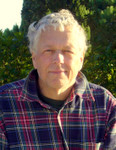 By Verena Schwippert
By Verena Schwippert
Northern Europe has many large erratic granite boulders that have traveled south from the Scandinavian mountains during one of the ice ages eons ago. In Germany they are called Findlinge which literally translated means foundlings. A good number of these old well-traveled boulders have been venerated by people from time immemorial.
In the late Stone Age communities built large ceremonial buildings and huge graves with them (some boulders as heavy as 40 ton were used). In the times since then, they have been part of the village life, often been given a name, and important ceremonies were held around them. In Lithuania, resides one giant flat-topped rock on which the surrounding villages still celebrate their weddings.
These days the law has put most of the large stones under its protection, yet there seem to be enough left over, or newly found in gravel pits, for Ben Siebenrock and very few other German stone sculptors to make sculptural art out of them.
Read more ...

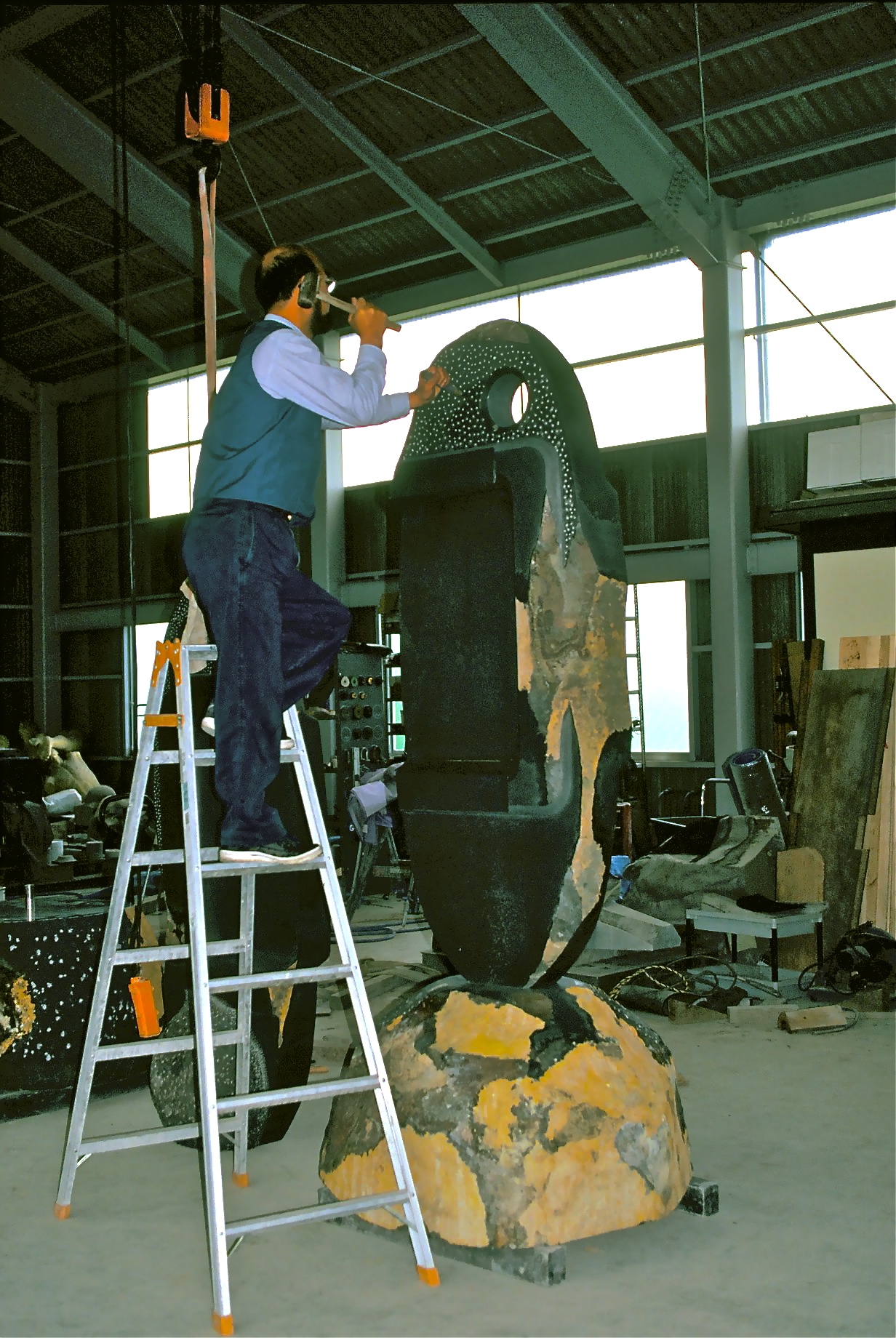
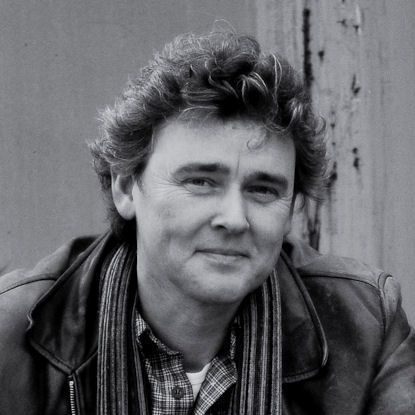
 Remember Hank Nelson? He used to be the supplier of power on the field of
Remember Hank Nelson? He used to be the supplier of power on the field of  Cloudstone
Cloudstone As Kirk Mc Lean observed, Hank has found his proper scale. And not size alone, the complexity, the engineering, the vision. Giant steel constructions reach for the sky. Some of the earthworks are huge cones of cobbles, with spiraling settings of larger stones, and capped with gray granite sculptures, standing and reclining. These are one and two ton pieces, but are dwarfed by their settings. There are canyons carved in the ground, scaped with steel and concrete rubble, like apocalyptic visions you can walk through, if you dare. We were all dumbfounded and overwhelmed. Our old buddy Hank Nelson is creating a marvel to rival any sculpture park anywhere. Uniquely inspiring, Hank’s work is beyond what most of us ever hope for, in power, intensity, and presence. It must be seen and touched, and walked in to be believed. By all means, get out to Whidbey and have a look. You will be amazed!
As Kirk Mc Lean observed, Hank has found his proper scale. And not size alone, the complexity, the engineering, the vision. Giant steel constructions reach for the sky. Some of the earthworks are huge cones of cobbles, with spiraling settings of larger stones, and capped with gray granite sculptures, standing and reclining. These are one and two ton pieces, but are dwarfed by their settings. There are canyons carved in the ground, scaped with steel and concrete rubble, like apocalyptic visions you can walk through, if you dare. We were all dumbfounded and overwhelmed. Our old buddy Hank Nelson is creating a marvel to rival any sculpture park anywhere. Uniquely inspiring, Hank’s work is beyond what most of us ever hope for, in power, intensity, and presence. It must be seen and touched, and walked in to be believed. By all means, get out to Whidbey and have a look. You will be amazed! By Verena Schwippert
By Verena Schwippert